Inventory of Occupational Risk from Natural Occurring Radioactive Materials (NORMs) in Soil Samples of the Coastal Region of Nigeria After Six Decades of Oil and Gas Exploration
| Received 08 Dec, 2021 |
Accepted 08 Mar, 2022 |
Published 01 Oct, 2022 |
Background and Objective: The occupational risks associated with exposure from radioactivity concentration of soil from oil and gases producing coastal areas of Nigeria have been assayed after sixty years of exploration activities in the area, to ascertain the radiological impact on the oil field workers and host communities. This study observes the occupational risk from natural occurring radioactive materials in soil samples. Materials and Methods: Gamma spectrometric technique was used to determine the radiometric in the soil samples collected using highly efficient thallium activated 3"×3" gamma spectrometer. Results: The mean activity concentration of the three natural radionuclides of 40K, 238U and 232Th are 1586.82±17.97, 27.26±8.38 and 37.67±9.55 Bq kg–1, respectively. The occupational risk estimates from three exposure routes, external, inhalation and ingestion were calculated using the specific activities of the radio nuclides detected in the soil samples. Radioactivity concentrations measured in the communities were found to be higher than their corresponding standard values. The estimated total effective dose received by the residents and oil field workers through the three exposure routes ranged from 0.2-14.8 mSv y–1 with a mean value of 4.77 mSv y–1. The values of each of the total effective doses estimated in the different communities exceeded the 1.0 mSv y–1 permissible limit. The dose equivalent estimate obtained for external exposure is 4.27 μSv y–1 which represents 89.0% of the permissible limit. Conclusion: These results obtained show that both residents and oil field workers are significantly exposed to radiation from the soil which may be of radiological health concern.
| Copyright © 2022 Oghenenyerhovwo and Esi. This is an open-access article distributed under the Creative Commons Attribution License, which permits unrestricted use, distribution, and reproduction in any medium, provided the original work is properly cited. |
INTRODUCTION
Consequent to the discovery of crude oil and gas in the Niger Delta Region of Nigeria in 1956, the exploration and exploitation of these natural resources have been a continuous one unabated. Not the civil war between 1966 and 1970 could hinder the operations of the multinationals involved in this oil and gas exploration. The human and environmental impact of the exploration activities of these natural resources has been a subject of debate in the national discourse. However, research findings in recent times have revealed that the rural dwellers and oil field workers in the region are continually exposed to radiation hazards from gamma radiation and internal exposure resulting from the inhalation of radon gas from gas flairs, radiation from industrial radiography, automated ionizing radiation gauge, well logging, use of radiotracers in pipes, mapping and evaluation of geological formation1-4. Ironically, most of these studies are restricted to the onshore area of the Niger Delta Region leaving the swamp/coastal areas unreached due to lack of ease of access occasioned by the difficult nature of the terrain. This research work is set out to reach these hitherto unassessed areas of the coastal communities for proper evaluation of the occupational risk associated with oil and gas activities on the soil radioactivity, after sixty years of oil and gas exploration activities in the region.
Natural radioactive elements are found in the natural mineral and mineral-laden materials deposits in suitable geological formations and they manifest in outcrops thereby elevating the background ionizing radiation(terrestrial and extra-terrestrial sources)5,6. Thus, Naturally Occurring Radioactive Material (NORM) and the associated external exposure due to gamma radiation depended largely on the geological formation while artificial sources are due to medical and industrial activities7-10. Research has revealed that man and its environment are exposed to ionizing radiations emission knowingly or unknowingly. And when the man is exposed to radiation at a high level, it can lead to a wide range of health challenges which includes cancer of the lung, bone and skin, kidney diseases and blood infections. Chronicle effects include alteration in the human genetic make-up, deterministic effect, stochastic effects, irritations, sensitization, embryonic effects, etc.11,12. To evaluate man’s safety to the exposure to radiation, there is a need to understand the distribution of radio nuclide’s in the soil is one of the chief lives supports of man and other living things in the environment13.
The Coastal Region of Nigeria where oil and gas exploration started in 1957, is characterized by the sedimentary rock of the Niger Delta Basin which is mainly Cenozoic in age14. Most sedimentary mineral deposits such as limestone, shale and hydrocarbon are associated with radionuclides like uranium, thorium and their progenies15,16. The drilling of oil and gas in the region is through the use of a beam pump, which utilizes the pressure of the gas in the reservoir, pressuring the oil up and into the well16. A similar process of crude oil extraction that is being proposed and may soon be deployed for oil drilling includes water and steam injections, shale gas extraction like fracking16. All these crude oil and gas exploration techniques are the probable cause of the increase in radioactive materials at the surface, as part of the flow back. These in most times find their way into the oil field soil through oil spills and gas flares. Besides these, operating companies deploy some radioactive materials during good drilling and work over (mud, well logging gauges), which may also add to the rise in the activities of the radionuclides beyond the normal background level9.17. Accidental discharges, equipment failures and pipelines vandalization may cause oil spilled, sludge, produced water, effluents, leachates and scales to pollutethe coastal environment1. These pollutants are transported into the soil compartment of the coastal ecosystem gravitationally due to seepage, which can also increase the specific activities of the soil in the environment18. The Technologically Enhanced Naturally Occurring Radioactive Materials (TENORM) in the soil in the oil and gas industry has the potential to cause both internal and external exposures during production due to the accumulation of gamma emitted radiation exposure hazard to both workers and members of the public through the inhalation and ingestion of radionuclides9,19,20.
The assessment of the levels of environmental and human exposure to radiations from soil and other naturally occurring radioactive materials have been reported in previous studies21-25. Literature abound also on research works that have been undertaken to precisely quantify the number of radioactivity levels in different soil and solid minerals found in Nigeria in recent time1,3,4,26,27 and in some countries of the world for radiation protection28-36. In Northern and Western Nigeria, a sizeable number of research works have also been conducted in this regard37-39. It is worth mentioning that investigation on the level of dosage and excess level of radiation in the risk of cancer in this area has been reported in literatures40,41. It, however, appears that not much work has been done on occupational risk estimation from the soil, especially in these study areas, as kinds of literature on the occupational risk assessment are lacking. This work, therefore aimed at estimating the occupational risk due to radionuclides alongside other risk parameters in the soil from these oil and gas producing coastal environments of the Niger Delta Region of Nigeria after six decades of oil and gas exploration activities.
MATERIALS AND METHODS
Description of study area: The study area is located between latitudes 5°18' and 5°30' North and longitudes 5°54 and 5°45' East of the Niger Delta Region of Nigeria with an elevation of 3.0 m above sea level. It bounded to the south by the Atlantic Ocean. It is one of the highest producers of oil and gas in the Niger Delta Region of the country.
Sample collection and preparation: In the study areas, sixty soil samples (four from each community) were collected at different sampling points from fifteen communities using a standard method1,40-42. About 3 kg of soil samples were collected and stored in a sealed and labelled black polythene container to avoid cross-contamination before and during transport to the laboratory. They were sprayed on stainless steel trays after which they were separately crushed and sieved through a 2 mm mesh sieve. The sieved smooth samples were weighed into special sampling containers which were then tightly sealed and stored in the laboratory for not less than four weeks to reach secular equilibrium.
Sample analysis: The activity concentrations of each soil sample were determined using gamma spectrometry at the National Institute of Radiation Protection and Research Centre (NIRPR), University of Ibadan, using a Canberra HpGe detector, with a relative efficiency of 29% and an energy resolution of 1.8 keV for 60Co γ-ray energy line at 1332 keV.
The detector was enclosed in a graded lead shield (Model 747, USA) and connected to DSA-1000 (Canberra, USA) for data acquisition and the spectrum was analyzed by GENIE- 2000 software. The energy calibration was performed using the standard reference radionuclide sources: 60Co, 137Cs and 154Eu, while the efficiency calibration was performed using the reference soil (238U, 226Ra, 228Ra, 232Th and 40K) obtained from the IAEA laboratory, Vienna. The activity concentration of 40K was directly determined using the 1460.8 keV photo peak. For 232Th, the photo peaks of 212Pb (238.6 keV), 208Tl (583.1 kev) and 228Ac (911.1 keV) were used. The 226Ra concentration was derived from 214Bi (609.3 keV) and 214Pb (295.2 and 352.0 keV) in the same pattern. The well-known interference between the gamma line of 186.2 keV of 226Ra and 185.7 keV emitted by 235U is inevitable, especially in the presence of a high uranium concentration43,44. Therefore, the above-mentioned lines were not used for the determination of 226Ra. High-level shielding against the environmental background radiation was achieved by counting in the Canberra 100 mm thick lead castle. Since the accuracy of the quantitative measurements is dependent on the calibration of the spectrometry system and adequate energy, background measurement and efficiency calibration of the system was made possible using Cs-137 standard source from IAEA, Vienna. Spectrum was accumulated for background for 29000 sec at 900 volts to produce strong peaks at gamma-emitting energies of 1461 keV for 40K, 609 keV of 214Bi and 911 keV of 228Ac, which were used to estimate the concentration of 238U (226Ra) and 232Th (228Ra), respectively. The energy resolution of the detector using Cs-137 from the International Atomic Energy Agency (IAEA) is 18% at 662 keV Cs-137 line, while the activity of the standard at the time of calibration is 25.37 K Bq. The background spectrum measured under the same conditions for both the standard and sample measurements were used to correct the calculated sample activities concentration in accordance with3,4,27,45-47. The activity concentrations in Bq kg–1 of the radio nuclides in the samples were calculated after subtracting decay correction using the expression:
| (1) |
| Cs | = | Sample concentration |
| NEy | = | Net peak area of a peak at energy |
| ɛEy | = | Efficiency of the detector for a γ-energy of interest |
| Ms | = | Sample mass |
| tc | = | Total counting time |
| Pγ | = | Emission probability of radionuclide of interest1 |
Total effective dose: The total effective dose parameters representing the occupational risk to host communities, oil and gas workers and the public’ were estimated employing relevant conversion coefficients available in the literature (Table 2) using the Eq.48:
| (2) |
| (3) |
| (4) |
Where:
| Ai | = | Specific activity of nuclide i in Bq kg–1 |
| Cext | = | Effective dose coefficient for the nuclide in the contaminated surface measured in Sv h–1/Bq g–1 |
| Cinh | = | Dose coefficient for inhalation of the nuclide measured in Sv Bq–1 |
| ηinh | = | Breathing rate measured in m3 h–1 |
| Df | = | Dust loading factor |
| Cing | = | Dose coefficient for ingestion of the nuclide measured in Sv Bq–1 |
| ηing | = | Ingestion rate for adults, measured in kg h–1 |
| Te | = | Exposure duration in the number of years |
RESULTS AND DISCUSSION
The mean results of radionuclide concentrations and the calculated effective dose from the three exposure routes of soil samples are presented in Table 1 and 2, is the standard dose coefficients used in the estimation of the effective dose in the soil sample and Table 3 is the computed effective dose values while the statistical comparison results with standard and contour maps are presented in Fig. 3-7.
The average specific activity concentrations of the natural radionuclides measured in soil samples collected from the Coastal Area of Nigeria are as shown in Table 1. The obtained average values of 40K ranged from 40.7±5.81 Bq kg–1 in Koko community to 4255.73±123.26 Bq kg–1 in the Okpele-ama community with a mean value of 1586.82±17.97 Bq kg–1and a control value of 36.54±7.11 Bq kg–1obtained from a non-oil producing community from Aladja community of the same geological formation. The elevated 40K value obtained in the Okpele-ama community may be attributed to the spill of hydrocarbon that has impacted the environment and the presence of oil sludge and scrabs material from the oil well. The 238U average values ranged from Below Detection Level (BDL) in Okerenkoko to 51.54±12.41 Bq kg–1 in Abigborodo with a mean value of 27.26±12.41 Bq kg–1and a control value of 12.19±0.43 Bq kg–1.
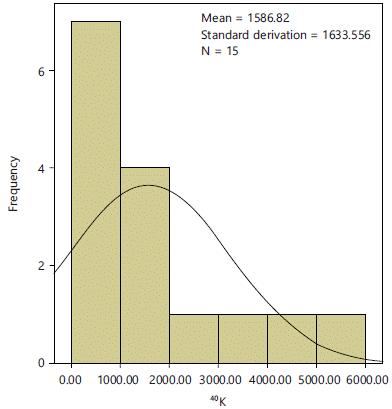 Fig. 1: Frequency distribution histogram of 40K Bq kg-1 in soil samples |
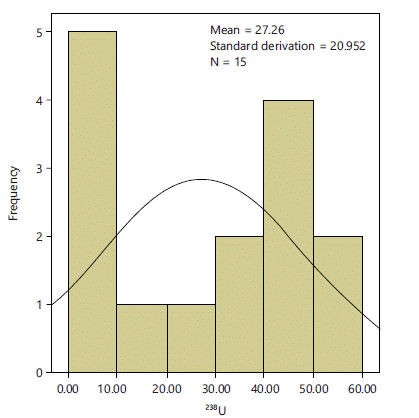 Fig. 2: Frequency distribution histogram of 238U Bq kg-1 in soil samples |
The low value of 238U recorded may be attributed to the low activities of oil and gas exploitation and exploration in the Okerenkoko community fringe which only host only crude and gas delivering pipelines. However, the elevated 238U value recorded in Abigborodo may not be unconnected with the combined activities of trucking of crude oil and the flow station operational activities which normally through up radon gas and NORM from these facilities coupled with oil spill within the flare stack and bund wall area where measurements were taken. The 232Th average values ranged from 5.92±0.6 Bq kg–1 in Oporoza community to 99.60±19.81 Bq kg–1 in the Akpele-ama community with a mean value of 37.67±9.55 Bq kg–1 and a control value of 3.61±1.09 Bq kg–1.
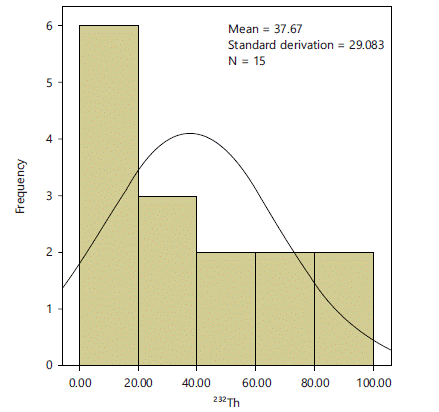 Fig. 3: Frequency distribution histogram of 232Th Bq kg-1 in soil samples |
| Table 1: | Average specific activity concentration of 40K, 238U and 232Th (Bq kg-1) results in soil samples | |||
Average activity |
|||
| Communities | 40K (Bq kg–1) |
238U (Bq kg–1) |
232Th (Bq kg–1) |
| Burutu | 1031.58±62.14 |
24.44±5.40 |
28.63±2.78 |
| Yeye | 535.3±297.9 |
48.87±22.02 |
60.60±16.8 |
| Ogulagha | 2187.86±25.53 |
54.42±12.07 |
32.33±3.17 |
| Forcados | 1428.18±33.39 |
45.10±20.35 |
38.75±9.06 |
| Odimodi | 5566.18±304.74 |
30.93±7.38 |
87.22±8.04 |
| Okerenkoko | 608.81±40.81 |
BDL |
12.9±1.27 |
| Kunukunuma | 1095.14±66.89 |
2.85±0.68 |
18.76±1.89 |
| Benikurukuru | 770.52±49.71 |
36.50±8.10 |
11.21±1.21 |
| Oporoza | 1201.81±72.90 |
0.16±0.04 |
5.92±0.61 |
| Okpele-Ama | 4255.73±123.26 |
4.11±1.09 |
99.60±19.81 |
| Koko | 40.70±5.81 |
3.02±0.77 |
15.82±1.55 |
| Abigborodo | 904.15±64.84 |
51.54±12.41 |
41.64±13.29 |
| Tebu | 466.01±32.73 |
47.59±21.42 |
62.67±5.84 |
| Tisum | 3634.31±52.42 |
42.04±9.90 |
44.07±17.38 |
| Kolokolo | 76.03±6.15 |
17.35±4.04 |
4.88±0.55 |
| Mean | 1586.82±17.97 |
27.26±8.38 |
37.67±9.55 |
| Control | 36.54±7.11 |
12.19±0.43 |
3.61±1.09 |
From the 232Th values recorded, the elevated values observed atAkpele-ama community can be attributed to operational activities of the oil multinational companies including tank farm and pigging manifold that are present and being maintained.
Table 2 are some of the constants used for the computation of effective doses while Table 3 presents the calculated effective doses in soil incurred by residents of the coastal area of the region from 238U and 232Th which are the parent’s radionuclides.
The calculated effective dose values of soil samples due to external exposure to contaminated surfaces (Dext) ranged from 0.1557-13.6953 μSv y–1 with an average value of 4.2706 μ Sv y–1. The effective dose values due to inhalation pathway (Dinh) ranged from 0.0282-0.8033 μSv y–1, with an average value of 0.3674 μSv y–1 while that from accidental ingestion (Ding) values ranged from 0.0229-0.3118 μSv y–1, with the average value of 0.1288 μSv y–1.
| Table 2: | Dose coefficients and other risk parameters adopted in this study48 | |||
| Parameters | Values |
226Ra |
232Th |
40K |
| Breathing rate, ηinh (m3 h–1) | 1.69 |
|||
| Dust loading factor, Df (g m–3) | 1×10−3 |
|||
| Ingestion rate, ηing (kg h–1) | 5×10−6 |
|||
| Duration of exposure, T (h y–1) | 2000 |
|||
| Effective dose coefficient, Cext (nSv h–1 Bq kg–1) | 9.929 |
0.003 |
1.175 |
|
| Dose coefficient for inhalation, Cinh (Sv Bq–1) | 2.20E-06 |
2.90E-05 |
3.00E-09 |
|
| Dose coefficient for ingestion, Cing (Sv Bq–1) | 2.80E-07 |
2.20E-07 |
6.20E-09 |
| Table 3: | Calculated effective dose in soil samples from the three exposure routes due to radio nuclide activity |
|||
| S/No | Communities | Effective dose (μSv y–1) |
Total effective dose |
||
Dext |
Dinh |
Ding |
(mSv y–1) |
||
| 1 | Burutu | 2.9097 |
0.2892 |
0.0977 |
3.2966 |
| 2 | Yeye | 2.2288 |
0.4238 |
0.1517 |
2.8043 |
| 3 | Ogulagha | 6.2223 |
0.6298 |
0.1796 |
7.0317 |
| 4 | Forcados | 4.2521 |
0.4841 |
0.15 |
4.8862 |
| 5 | Odimodi | 13.6953 |
0.8033 |
0.3118 |
14.8103 |
| 6 | Okerenkoko | 1.4308 |
0.063 |
0.0331 |
1.5269 |
| 7 | Kunukunuma | 2.6303 |
0.1341 |
0.0586 |
2.823 |
| 8 | Benikurukuru | 2.5356 |
0.3507 |
0.0873 |
2.9736 |
| 9 | Oporoza | 2.8275 |
0.1237 |
0.044 |
2.9951 |
| 10 | Okpele-Ama | 10.0832 |
0.4722 |
0.2472 |
10.8026 |
| 11 | Koko | 0.1557 |
0.0282 |
0.0229 |
0.2068 |
| 12 | Abigborodo | 3.1485 |
0.4792 |
0.146 |
3.7736 |
| 13 | Tebu | 2.0405 |
0.4075 |
0.15 |
2.598 |
| 14 | Tisum | 9.3757 |
0.6856 |
0.22 |
10.2813 |
| 15 | Kolokolo | 0.5232 |
0.1372 |
0.032 |
0.6925 |
| Mean | 4.2706 |
0.3674 |
0.1288 |
4.7668 |
|
| Min | 0.1557 |
0.0282 |
0.0229 |
0.2068 |
|
| Max | 13.6953 |
0.8033 |
0.3118 |
14.8103 |
|
The total effective dose received by the residents through the three exposure routes ranged from 0.2068 mSv y–1 at Koko community to 14.8103 mSv y–1 at Odimodi community with an average value of 4.7668 mSv y–1 in Table 3.
The bell-shaped frequency distribution of the measured radionuclide’s was analyzed and the histograms are as shown in Fig. 1-3. The histograms distributions explained the even distribution of the measured radionuclides in the coastal area of the Niger Delta Region of Nigeria. The histograms show that 238U, 232Th and 40K exhibited some degree of multi-modality. The multi-model feature of the radioelements demonstrates the complexity and variation in the origin of radioactive laden minerals in soil samples that are the sources of the natural radioactivity concentrations.
The contour maps of mean specific activity concentrations of the radionuclides (238U, 232Th and 40K) distribution in soil samples in the coastal communities studied are as shown in Fig. 4-6. The dense contour lines of the locations show generally higher activity values, while the less dense areas show low activity values and these can be observed in the contour maps of the three natural radionuclides. The observed relatively high radionuclide concentrations of the three radionuclides in almost all the communities investigated indicate that radionuclide emitters may have been introduced over time into the environment which probably has elevated the natural radioactivity level, which can be traced to the oil and gas exploration, exploitation and production activities in the area, which deploy and use some of the radiation generators on a large scale for industrial radiography, automatically ionizing radiation gauge, well logging, use of radiotracers in pipes, mapping and evaluation of geological formation and the extraction of other natural hydrocarbon resources49.
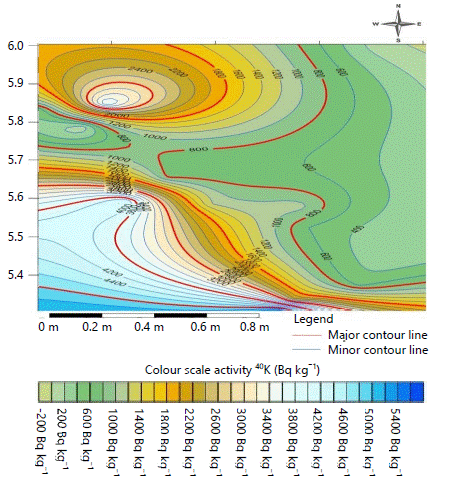 Fig. 4: Mean specific activity concentration results from 40K Bq kg-1 for soil |
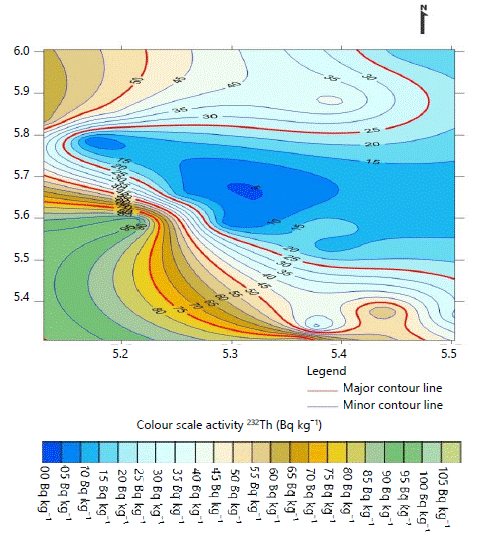 Fig. 5: Mean specific activity concentration results from 232Th Bq kg-1 for soil |
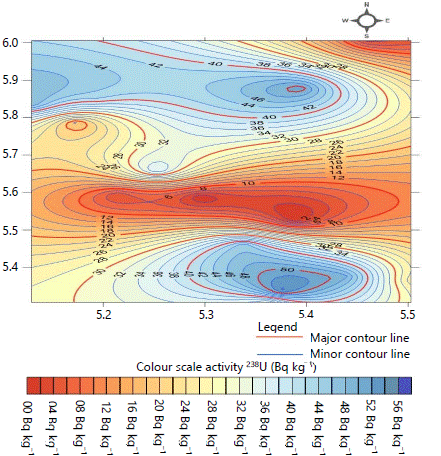 Fig. 6: Mean specific activity concentration results from 238U Bq kg-1 for soil |
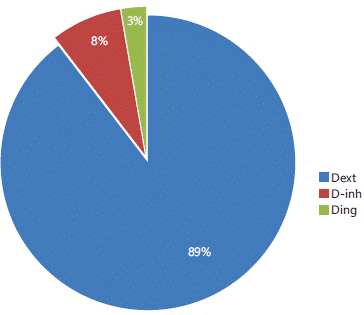 Fig. 7: Percentage contribution of total effective dose in soil samples |
The results of the calculated ingested doses from the soil by residents of the coastal area of the oil-producing area for these six decades from these natural radionuclides revealed that the total effective doses obtained in all the communities’ soil samples are higher than the recommended permissible limit of 1.0 mSv y–1 50. These values are also higher than previously estimated values reported by Kolo et al.48. The results showed that the most significant exposure pathway in soil samples is the external exposure which accounted for about 89.0%, inhalation 8.0% and the least significant is the ingestion which accounted for 3% as shown in Fig. 7. These high effective dose values may also be traced to oil and gas exploration, exploitation and production activities which includes oil spillage, discharge of oil and gas waste (produced water, used drilling mud) into the environment.
The results of the average specific activity concentrations of the natural radionuclides measured in soil samples collected from the coastal area of Nigeria are as shown in Table 1, which shows that the mean values obtained for 40K and 232Th are higher than the standard recommended permissible limit for the public while 238U is within its permissible limit for the public9. The average specific activity concentrations of the samples in the studied areas varied significantly from one community to the others across the fifteen communities investigated. This is an indication of the varying degree of impact of human activities on the soil environment. But these results obtained are in agreement with previous studies on soil and sediments in the oil and gas exploration area of the Niger Delta Region of Nigeria and other soil of solid mineral deposit1,3,4,26,27,37-39,49. A comparison of the average radioactivity concentration in soil samples in the oil and gas exploitation activities of the Coastal Region with the control sample (within the same area but without any oil and gas exploration activities) reveals that all soil samples of the studied areas are well above the control samples in the three natural radionuclides investigated. Thus, the use of soil in the oil and gas exploitation areas of the Coastal Region for either building materials or other industrial/domestic purposes may lead to radiation exposure beyond the ambient levels which can pose some levels of radiological health impact to the residents and dwellers of the areas. According to the European Commission document on reference levels for workplace processing Naturally Occurring Radioactive Materials (NORMs)49, high level of regulation and/or individual doses assessment of workers/dwellers may be required if these soil samples are used as building materials.
The radioelements histograms of 238U, 232Th and 40K exhibiting some degree of multi-modality revealed the complexity of radioactive laden minerals in soil samples found in this oil-rich region of Nigerian.
The obtained contour maps of the radionuclide’s (238U, 232Th and 40K) showing the distribution of some dense contour lines and less dense areas show variation in the radionuclide distribution in the area which goes beyond NORM in geological formations. The alteration of the environmental NORM may have been introduced over time into the environment through the oil and gas exploration activities which probably have elevated the natural radioactivity level49,50. This research work has shown that the most significant exposure pathway of soil samples into man is the external exposure which accounted for about 89.0%, inhalation 8.0% and the least significant is the ingestion which accounted for 3.0%. The high radioactive dose values are attributable to the activities of oil and gas exploration, exploitation and production activities over the years in the study environment.
CONCLUSION
The evaluation of the radioactivity concentration of soil samples from the oil and gas producing area of the Coastal Niger Delta has been carried out after sixty years of oil and gas exploration activities. Soil samples from the Coastal Region of Nigeria were characterized for their activity concentrations (238U, 232Th and 40K) using a gamma spectrometer. The obtained average radio nuclide concentrations values were higher than the standard except for 238U which is lower than the permissible limit for the public. And all measured radio nuclides activity concentrations in the studied areas were higher than the control samples. The estimated total effective dose received by residents and oil and gas workers in the coastal communities through the three exposure routes were found to be higher than the recommended permissible safety limit of 1.0 mSv y–1. External exposure accounted for 89.0% which place it as the most significant exposure pathway for the field workers and the residents. The overall results indicate that the coastal communities’ soil is radiologically impaired and thus not safe for building constructions. There is, therefore, the need for proper treatment of oil and gas waste in the coastal area before disposal and processional handling of possible radiation-emitting machines, reduction in gas flair and other activities of the oil and gas multinationals that may tend to aggravate the radiation levels of the coastal areas.
SIGNIFICANT STATEMENT
The study examined the radiological impact of oil and gas exploration activities on the host community residents and the oil field workers in the study area after intense oil and gas exploration for sixty years in the area, using soil as the test case. The results of the radioactivity analyses on the soil samples examined shows that the residents and the field workers in these oil and gas fields environment are significantly and radiologically impacted by the oil and gas activities in the area.
REFERENCES
- Agbalagba, E.O., G.O. Avwiri and Y.E. Chad-Umoren, 2012.γ-Spectroscopy measurement of natural radioactivity and assessment of radiation hazard indices in soil samples from oil fields environment of Delta State, Nigeria. J. Environ. Radioact., 109: 64-70.
- Agbalagba, E.O., O.N. Nenuwe and L.R. Owoade, 2019. Geophysical survey of groundwater potential and radioactivity assessment of soil depth lithology for drinking water-quality determination. Environ. Earth Sci.
- Kingsley, A.C., A.O. Gregory and O.P. Chinyere, 2019. Occupational hazards from BIR in selected crude oil production pipes storage locations in Niger Delta Region of Nigeria. Curr. J. Appl. Sci. Technol.
- Babatunde, B.B., F.D. Sikoki, G.O. Avwiri and Y.E. Chad-Umoreh, 2019. Review of the status of radioactivity profile in the oil and gas producing areas of the Niger Delta Region of Nigeria. J. Environ. Radioact., 202: 66-73.
- Ibrahim, U., T.C. Akpa and I.H. Daniel, 2013. Assessment of radioactivity concentration in soil of some mining areas in Central Nasarawa State, Nigeria. Sci. World J., 8: 7-12.
- Kavitha, E., L. Paramesh and M.S. Chandrashekara, 2016. Studies on radioactivity elements in soil samples of Cauvery River Basin, South Interior Karnataka State, India. J. Nucl. Technol. Appl. Sci., 4: 75-81.
- Ramasamy, V., G. Suresh, V. Meenakshisundaram and V. Gajendran, 2009. Evaluation of natural radionuclide content in river sediments and excess lifetime cancer risk due to gamma radioactivity. Res. J. Environ. Earth Sci., 1: 6-10.
- Oni, O.M., I.P. Farai and A.O. Awodugba, 2011. Natural radionuclide concentrations and radiological impact assessment of river sediments of the Coastal Areas of Nigeria. J. Environ. Prot., 2: 418-423.
- Avwiri, G.O. and C.P. Ononugbu, 2012. Natural radioactivity levels in surface soil of ogba/egbema/ndoni oil and gas fields. Energy Sci. Technol., 4: 92-101.
- Al Mugren, K.S., 2015. Assessment of natural radioactivity levels and radiation dose rate in some soil samples from historical area, Al-Rakkah, Saudi Arabia. Nat. Sci., 7: 238-247.
- Sivakumar, S., A. Chandrasekaran, R. Ravisankar, S.M. Ravikumar and J.P.P. Jebakumar et al., 2014. Measurement of natural radioactivity and evaluation of radiation hazards in coastal sediments of East Coast of Tamilnadu using statistical approach. J. Taibah Univ. Sci., 8: 375-384.
- Kessaratikoon, P., R. Boonkrongcheep, S. Benjakul and U. Youngchauy, 2013. Specific activities and radioactive contour maps of natural and anthropogenic radionuclides in beach sand samples (Patong, Kamala, Kata, Karon and Nai yang) after tsunami disaster in Phuket Province, Thailand. J. Radioanal. Nucl. Chem., 297: 247-255.
- Tholkappian, M., A. Chandrasekaran, N. Harikrishnan, D. Ganesh, G. Elango and R. Ravisankar, 2017. Measurement of natural radioactivity in and around Chennai Coast, East Coast of Tamil Nadu, India, using gamma ray spectrometry. Radiat. Prot. Environ., 40: 9-12.
- Numbere, A.O. and G.R. Camilo, 2016. Reciprocal transplant of mangrove (Rhizophora racemosa) and Nypa palm (Nypa fruticans) seedlings in soils with different levels of pollution in the Niger River Delta, Nigeria. Global J. Environ. Res., 10: 14-21.
- Aliyu, A.S., U. Ibrahim, C.T. Akpa, N.N. Garba and A.T. Ramli, 2015. Health and ecological hazards due to natural radioactivity in soil from mining Areas of Nasarawa State, Nigeria. Isotopes Environ. Health Stud., 51: 448-468.
- Xhixha, G., M. Baldoncini, I. Callegari, T. Colonna and F. Hasani et al., 2015. A century of oil and gas exploration in Albania: Assessment of naturally occurring radioactive materials (NORMs). Chemosphere, 139: 30-39.
- Ademola, J.A. and S.I. Ehiedu, 2010. Radiological analysis of 40K, 226Ra and 232Th in fish, crustacean and sediment samples from fresh and marine water in oil exploration Area of Ondo State, Nigeria. Afr. J. Biomed. Res., 13: 99-106.
- Alhajji, E., M.S. Al-Masri, H. Khalily, B.E. Naoum, H.S. Khalil and A. Nashawati, 2016. A study on sorption of 226Ra on different clay matrices. Bull. Environ. Contam. Toxicol., 97: 255-260.
- Saleh, M.A., A.T. Ramli, Y. Alajerami and A.S. Aliyu, 2013. Assessment of natural radiation levels and associated dose rate from surface soils in Pontian District, Jahor, Malaysia. J. Ovonic Res., 9: 17-27.
- SureshGandhi, M., R. Ravisankar, A. Rajalakshmi, S. Sivakumar, A. Chandrasekaran and D.P. Anand, 2014. Measurements of natural gamma radiation in beach sediments of North East Coast of Tamilnadu, India by gamma ray spectrometry with multivariate statistical approach. J. Radiat. Res. Appl. Sci., 7: 7-17.
- Diab, H.M., S.A. Nouh, A. Hamdy and S.A. El-Fiki, 2008. Evaluation of natural radioactivity in a cultivated area around a fertilizer factory. J. Nucl. Radiat. Phys., 3: 53-62.
- Senthilkumar, B., V. Dhavamani, S. Ramkumar and P. Philominathan, 2010. Measurement of gamma radiation levels in soil samples from Thanjavur using γ-ray spectrometry and estimation of population exposure. J. Med. Phys., 35: 48-53.
- Harb, S., A.H. El-Kamel, A.M. Zahran, A. Abbady and F.A. Ahmed, 2014. Natural radioactivity measurements of basalt rocks in Aden governorate, South of Yemen on Gulf of Aden. IOSR J. Appl. Phys., 5: 39-48.
- Avwiri, G.O., J.M. Egieya and C.P. Ononugbo, 2013. Radiometric survey of aluu landfill, in Rivers State, Nigeria. Adv. Phys. Theor. Appl., 22: 24-30.
- Essiett, A.A., I.E. Essien and M.C. Bede, 2015. Measurement of surface dose rate of nuclear radiation in Coastal Areas of Akwa Ibom State, Nigeria. Int. J. Phys., 3: 224-229.
- Sadiq, A.A. and E.H. Agba, 2011. Background radiation in Akwanga, Nigeria. Facta Universitatis Ser. Working Living Environ. Prot., 8: 7-11.
- Ademola, J.A. and U.C. Onyema, 2014. Assessment of natural radionuclides in fly ash produced at Orji River thermal power station, Nigeria and the associated radiological impact. Nat. Sci., 6: 752-759.
- Belivermis, M., 2012. Vertical distributions of 137Cs, 40K, 232Th and 226Ra in soil samples from Istanbul and its environs, Turkey. Radiat. Prot. Dosim., 151: 511-521.
- Charro, E., R. Pardo and V. Peña, 2013. Chemometric interpretation of vertical profiles of radionuclides in soils near a spanish coal-fired power plant. Chemosphere, 90: 488-496.
- Kovács, T., G. Szeiler, F. Fábián, R. Kardos, A. Gregorič and J. Vaupotič, 2013. Systematic survey of natural radioactivity of soil in Slovenia. J. Environ. Radioact., 122: 70-78.
- Santawamaitre, T., D. Malain, H.A. Al-Sulaiti, D.A. Bradley, M.C. Matthews and P.H. Regan, 2014. Determination of 238U, 232Th and 40K activity concentrations in riverbank soil along the Chao Phraya river basin in Thailand. J. Environ. Radioact., 138: 80-86.
- Guidotti, L., F. Carini, R. Rossi, M. Gatti, R.M. Cenci and G.M. Beone, 2015. Gamma-spectrometric measurement of radioactivity in agricultural soils of the Lombardia Region, Northern Italy. J. Environ. Radioact., 142: 36-44.
- Hannan, M., K. Wahid and N. Nguyen, 2015. Assessment of natural and artificial radionuclides in mission (Texas) surface soils. J. Radioanal. Nucl. Chem., 305: 573-582.
- Milenkovic, B., J.M. Stajic, L. Gulan, T. Zeremski and D. Nikezic, 2015. Radioactivity levels and heavy metals in the urban soil of Central Serbia. Environ. Sci. Pollut. Res., 22: 16732-16741.
- Todorovic, N., I. Bikit, M. Krmar, D. Mrdja and J. Hansman et al., 2015. Natural radioactivity in raw materials used in building industry in Serbia. Int. J. Environ. Sci. Technol., 12: 705-716.
- Isinkaye, M.O. and H.U. Emelue, 2015. Natural radioactivity measurements and evaluation of radiological hazards in sediment of Oguta Lake, South East Nigeria. J. Radiat. Res. Appl. Sci., 8: 459-469.
- Ademola, A.K. and R.I. Obed, 2012. Gamma radioactivity levels and their corresponding external exposure of soil samples from tantalite mining areas in Oke-Ogun, South-Western Nigeria. Radioprotection, 47: 243-252.
- Innocent, A.J., M.Y. Onimisi and S.A. Jonah, 2013. Evaluation of naturally occurring radionuclide materials in soil samples collected from some mining sites in Zamfara State, Nigeria. Curr. J. Appl. Sci. Technol., 3: 684-692.
- Ademola, A.K., A.K. Bello and A.C. Adejumobi, 2014. Determination of natural radioactivity and hazard in soil samples in and around gold mining area in Itagunmodi, South-Western, Nigeria. J. Radiat. Res. Appl. Sci., 7: 249-255.
- Wahsha, M., E. Al-Absi, R. Manasrah, W. Al-Zyoud and C. Bini, 2016. The impact of uranium near a phosphate mining port on the environment in the Northern Gulf of Aquaba, Red Sea. Environ. Qual., 22: 25-32.
- Ugbede, F.O. and E.O. Echeweozo, 2017. Estimation of annual effective dose and excess lifetime cancer risk from background ionizing radiation levels within and around quarry site in Okpoto-Ezillo, Ebonyi State, Nigeria. J. Environ. Earth Sci., 7: 74-79.
- Ajayi, O.S., C.G. Dike and K.O. Balogun, 2018. Elemental and radioactivity analysis of rocks and soils of some selected sites in Southwestern Nigeria. Environ. Forensics, 19: 87-98.
- Zarie, K.A. and K.S. Al Mugren, 2010. Measurement of natural radioactivity and assessment of radiation hazard in soil samples from Tammy Area (KSA). Isotope Radiat. Res., 42: 1-9.
- Song, G., D. Chen, Z. Tang, Z. Zhang and W. Xie, 2012. Natural radioactivity levels in topsoil from the Pearl River Delta Zone, Guangdong, China. J. Environ. Radioact., 103: 48-53.
- Arogunjo, A.M., E.E. Ofuga and M.A. Afolabi, 2005. Levels of natural radionuclides in some Nigerian cereals and tubers. J. Environ. Radioact., 82: 1-6.
- Kabir, K.A., S.M.A. Islam and M.M. Rahman, 2009. Distribution of radionuclides in surface soil and bottom sediment in the District of Jessore, Bangladesh and evaluation of radiation hazard. J. Bangladesh Acad. Sci., 33: 117-130.
- Solehah, A.R. and S.B. Samat, 2018. Radiological impact from natural radionuclide activity concentration in soil and vegetables at former tin mining area and non-mining area in Peninsular Malaysia. J. Radioanal. Nucl. Chem., 315: 127-136.
- Kolo, M.T., M.U. Khandaker, Y.M. Amin and W.H.B. Abdullah, 2016. Quantification and radiological risk estimation due to the presence of natural radionuclides in Maiganga Coal, Nigeria. PLoS ONE.
- Rafique, M., S.U. Rahman, M. Basharat, W. Aziz and I. Ahmad et al., 2014. Evaluation of excess life time cancer risk from gamma dose rates in Jhelum Valley. J. Radiat. Res. Appl. Sci., 7: 29-35.
- Ugbede, F.O., 2020. Distribution of 40K, 238U and 232Th and associated radiological risks in river sand sediments across Enugu East, Nigeria. Environ. Nanotechnol. Monit. Manage.
How to Cite this paper?
APA-7 Style
Oghenenyerhovwo,
A.E., Esi,
O.E. (2022). Inventory of Occupational Risk from Natural Occurring Radioactive Materials (NORMs) in Soil Samples of the Coastal Region of Nigeria After Six Decades of Oil and Gas Exploration. Trends in Agricultural Sciences, 1(2), 65-77. https://doi.org/10.17311/tas.2022.65.77
ACS Style
Oghenenyerhovwo,
A.E.; Esi,
O.E. Inventory of Occupational Risk from Natural Occurring Radioactive Materials (NORMs) in Soil Samples of the Coastal Region of Nigeria After Six Decades of Oil and Gas Exploration. Trends Agric. Sci 2022, 1, 65-77. https://doi.org/10.17311/tas.2022.65.77
AMA Style
Oghenenyerhovwo
AE, Esi
OE. Inventory of Occupational Risk from Natural Occurring Radioactive Materials (NORMs) in Soil Samples of the Coastal Region of Nigeria After Six Decades of Oil and Gas Exploration. Trends in Agricultural Sciences. 2022; 1(2): 65-77. https://doi.org/10.17311/tas.2022.65.77
Chicago/Turabian Style
Oghenenyerhovwo, A., E., and Oghenevovwero Emmanuel Esi.
2022. "Inventory of Occupational Risk from Natural Occurring Radioactive Materials (NORMs) in Soil Samples of the Coastal Region of Nigeria After Six Decades of Oil and Gas Exploration" Trends in Agricultural Sciences 1, no. 2: 65-77. https://doi.org/10.17311/tas.2022.65.77

This work is licensed under a Creative Commons Attribution 4.0 International License.



